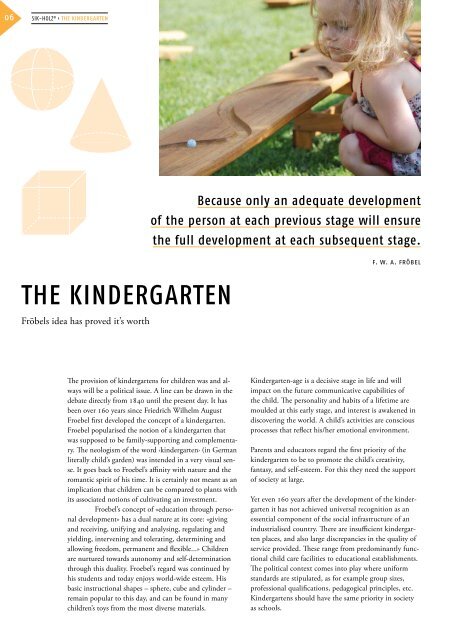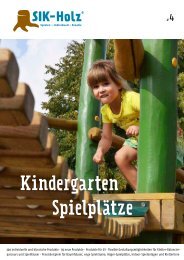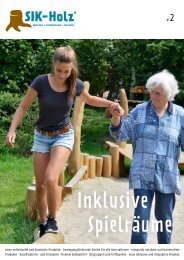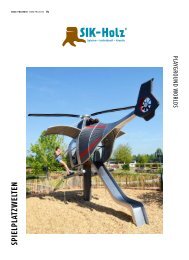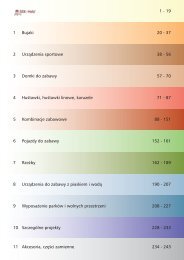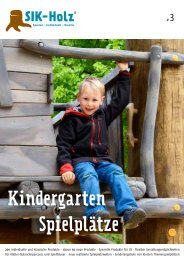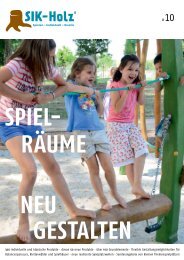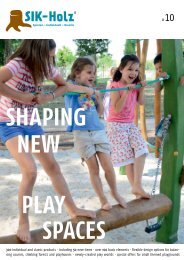sik_kita2015_en
Create successful ePaper yourself
Turn your PDF publications into a flip-book with our unique Google optimized e-Paper software.
06<br />
SIK-Holz® › The Kindergart<strong>en</strong><br />
Because only an adequate developm<strong>en</strong>t<br />
of the person at each previous stage will <strong>en</strong>sure<br />
the full developm<strong>en</strong>t at each subsequ<strong>en</strong>t stage.<br />
f. w. a. fröbel<br />
The Kindergart<strong>en</strong><br />
Fröbels idea has proved it’s worth<br />
The provision of kindergart<strong>en</strong>s for childr<strong>en</strong> was and always<br />
will be a political issue. A line can be drawn in the<br />
debate directly from 1840 until the pres<strong>en</strong>t day. It has<br />
be<strong>en</strong> over 160 years since Friedrich Wilhelm August<br />
Froebel first developed the concept of a kindergart<strong>en</strong>.<br />
Froebel popularised the notion of a kindergart<strong>en</strong> that<br />
was supposed to be family-supporting and complem<strong>en</strong>tary.<br />
The neologism of the word ‹kindergart<strong>en</strong>› (in German<br />
literally child’s gard<strong>en</strong>) was int<strong>en</strong>ded in a very visual s<strong>en</strong>se.<br />
It goes back to Froebel’s affinity with nature and the<br />
romantic spirit of his time. It is certainly not meant as an<br />
implication that childr<strong>en</strong> can be compared to plants with<br />
its associated notions of cultivating an investm<strong>en</strong>t.<br />
Froebel’s concept of «education through personal<br />
developm<strong>en</strong>t» has a dual nature at its core: «giving<br />
and receiving, unifying and analysing, regulating and<br />
yielding, interv<strong>en</strong>ing and tolerating, determining and<br />
allowing freedom, perman<strong>en</strong>t and flexible...» Childr<strong>en</strong><br />
are nurtured towards autonomy and self-determination<br />
through this duality. Froebel’s regard was continued by<br />
his stud<strong>en</strong>ts and today <strong>en</strong>joys world-wide esteem. His<br />
basic instructional shapes – sphere, cube and cylinder –<br />
remain popular to this day, and can be found in many<br />
childr<strong>en</strong>’s toys from the most diverse materials.<br />
Kindergart<strong>en</strong>-age is a decisive stage in life and will<br />
impact on the future communicative capabilities of<br />
the child. The personality and habits of a lifetime are<br />
moulded at this early stage, and interest is awak<strong>en</strong>ed in<br />
discovering the world. A child’s activities are conscious<br />
processes that reflect his/her emotional <strong>en</strong>vironm<strong>en</strong>t.<br />
Par<strong>en</strong>ts and educators regard the first priority of the<br />
kindergart<strong>en</strong> to be to promote the child’s creativity,<br />
fantasy, and self-esteem. For this they need the support<br />
of society at large.<br />
Yet ev<strong>en</strong> 160 years after the developm<strong>en</strong>t of the kindergart<strong>en</strong><br />
it has not achieved universal recognition as an<br />
ess<strong>en</strong>tial compon<strong>en</strong>t of the social infrastructure of an<br />
industrialised country. There are insuffici<strong>en</strong>t kindergart<strong>en</strong><br />
places, and also large discrepancies in the quality of<br />
service provided. These range from predominantly functional<br />
child care facilities to educational establishm<strong>en</strong>ts.<br />
The political context comes into play where uniform<br />
standards are stipulated, as for example group sizes,<br />
professional qualifications, pedagogical principles, etc.<br />
Kindergart<strong>en</strong>s should have the same priority in society<br />
as schools.


